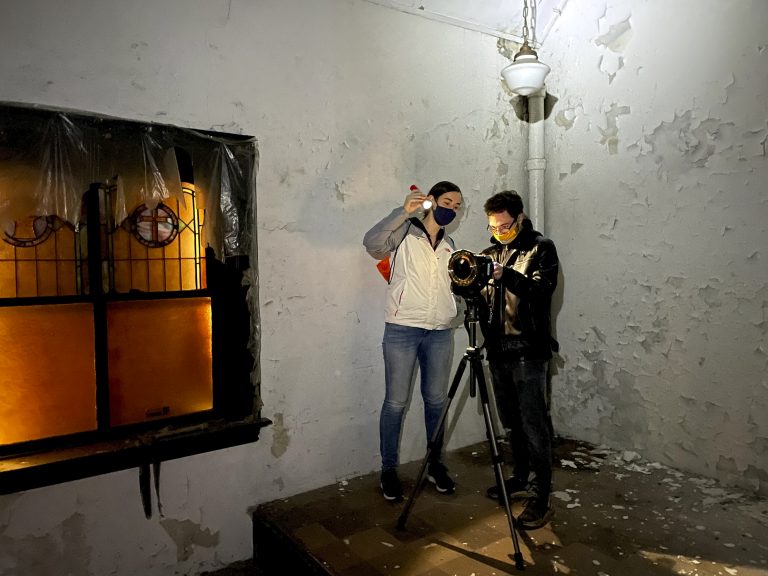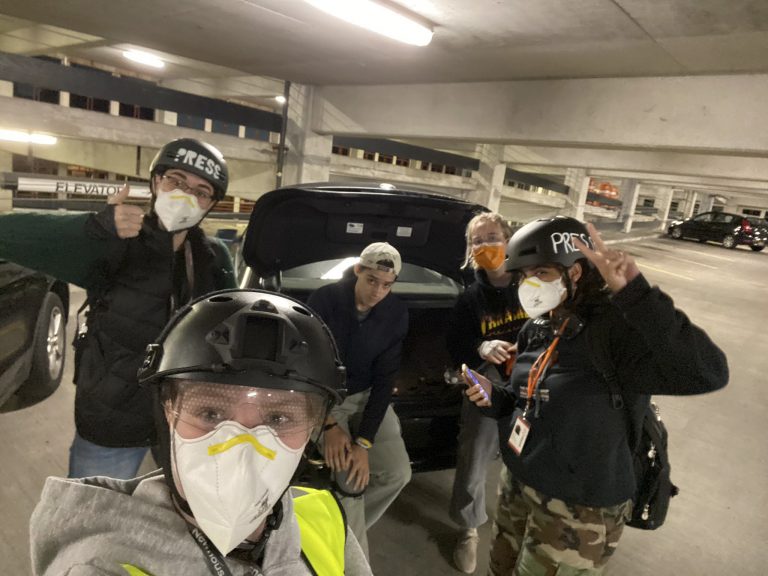About Deconstructing the Divide
Deconstructing the Divide: Revealing Syracuse’s Inequality
Dozens of Syracuse University students spent the school year reporting on inequality, producing more than 30 stories on race, gender, disability, the ways in which our society divides us, and the people fighting to construct a better tomorrow.

hy does inequality persist today and what can we do about it?
That is the question that motivated more than 100 student reporters, photographers, designers, editors, and producers to collaborate on dozens of stories, videos, illustrations, and data visualizations to examine what divides us, and what brings us together. The result: Deconstructing the Divide, produced by students who worked virtually and in person, abiding by all COVID-19 regulations.

A neighborhood-level analysis of economic opportunity reveals vast inequality within the city limits. We report on the impact that high lead levels have on Syracuse’s children. One story explores the complex relationship between the city and the university that shares its name.
On campus, the reporting chronicles the racism faced by Asian students and how anonymous social media accounts are raising the voices of marginalized students.
Several personal narratives provide an intimate look at the discrimination against Indigenous students, ableism faced by people with disabilities, and racism thrown at Black students taking classes at a predominately white institution.

There are more than 20 additional articles as well. One deals with the legacy of the Syracuse 8, who protested racial inequality in sports in the late 1960s. Another explains the food apartheid that exists in Syracuse. Others highlight the people working to make change, including protesters and community leaders.
But answering the question at hand turned out to be difficult. In part because of the invisible nature of the forces behind inequality. We know, for example, that the glass ceiling faced by women in America has not thinned despite higher academic achievement and women breaking ground in new industries. The effect COVID-19 has had on inequality is also still evolving. Education, often thought to help promote equality, has been unequally afforded to children in Syracuse. Cases of COVID-19 have disproportionately affected people of color in Syracuse, but communities of color have not received priority for vaccinations in Onondaga County.
So this project raises as many questions as it answers. But as a nuanced investigation into the forces that generate inequality within our university and our city, Deconstructing the Divide works to shine a light on the scourge of inequality and elevate the voices of people fighting against it.

The project represents hundreds of hours of work from student reporters, photographers, designers, and coordinators in the most difficult of circumstances. The pandemic forced several photoshoots and interviews to Zoom as the journalists and their sources confronted health scares, quarantines, and a rapidly evolving landscape of threats. Throughout the project, abiding by SU’s Stay Safe Pledge while reporting in the field was at the top of our minds, along with doing justice to these important stories.
The final presentation was a team effort, supported by nearly all of the faculty members in the Magazine, News, and Digital Journalism; Broadcast and Digital Journalism; and Visual Communications departments. Thank you to the countless faculty members who gave advice, helped recruit students, and connected reporters with sources.
Special thank you to Newhouse alumnus David Flaum and his wife, Jackie, who have been generous supporters of reporting experiences for Newhouse journalism students, including Deconstructing the Divide.

Student Project Coordinators
Content Director – Patrick Linehan
Design Director – Kevin Camelo
Social Media Director – Frankie Sailer
Visuals Director – Laura Oliverio
Supervising Faculty
Project Coordinator – Jon Glass
Content Coordinators – Shelvia Dancy, Ashley Kang, and Greg Munno
Site Developer & Design Coordinator – Seth Gitner
Editing Coordinator – Rawiya Kameir
Visuals Coordinator – Amy Toensing
Visualizing I-81 Coordinators – Dan Pacheco and Amber Bartosh
Project Team
Reporters & Producers
Emily Barnes
Lawry Boyer
Kate Brennan
Caleb Britt
Sonny Cirasuolo
Alycia Cypress
Nhari Djan
Michael Garcia
Sydney Gold
Brooke Kato
MaryKate Keevins
Violet Lazarus
Kaizhao Zero Lin
Yzzy Liwanag
Shrishti Mathew
Patrick McCarthy
Kate Minutillo
Marnie Muñoz
Matthew Nerber
Folabomi Olujimi
Domenica Orellana
Joey Pagano
Amanda Paule
Chandler Plante
Gianna Prudente
Adriana Rozas Rivera
Evan Starling-Davis
Isabelle Tavares
Jenna Webster
Jenna Wirth
Visual Journalists & Illustrators
Nina Bridges
Maddi Brown
Em Burris
Ben Cauz
Samantha Currier
Renée Deemer
Zoe Durham
Molly Gibbs
Lydia Herne
Emily Kenny
Zachary J. Krahmer
Josh Lee
Sarah Lee
Zoe McCreary
Lauren Miller
Amy Nakamura
Bond Demetri Photos
Jessica Ruiz
TJ Shaw
Amanda M. Smith
Shannon Smith
Jessica Stewart
JD Strong II
Wendy Wang
Digital Producers
Toby Craner
Casey Darnell
Matt Dzenawager
Danny Emerman
Emma Folts
Isaiah Freedman
Hannah Graf
Noah Lowy
Dominick Pfisterer
Henry Sutter
Abigail Weiss
Jacob Wolf
Social Media Coordinators
Taijay Blagrove
Charlene Masona
Content Editors
Izzy Bartling
Kambui Bomani
Ashley Clemens
Danielle Clough
Sarah Connor
KJ Edelman
Blessing Emole
Linnea Foote
Ethan Garcia
Hannah Graf
Alexander Hamer
Ayana Herndon
Ainsley Holman
Jillian Leveille
Shivani Reddy Manjunath
Morgaine Mcilhargey
Owen Mitchell
Benjamin Oleksinski
Rachael Rosenthal
Kristin Ross
Zoe Selesi
Mallory Stokker
Kyra Surgent
Gianna Valente
Vivian Whitney
Rubin Wright
Gianna Valente

